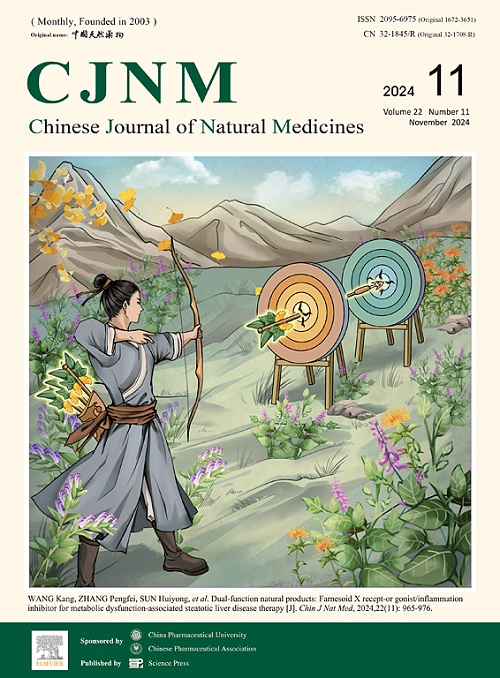A CYP80B enzyme from Stephania tetrandra enables the 3'-hydroxylation of N-methylcoclaurine and coclaurine in the biosynthesis of benzylisoquinoline alkaloids
IF 4.9
2区 医学
Q1 INTEGRATIVE & COMPLEMENTARY MEDICINE
引用次数: 0
Abstract
Benzylisoquinoline alkaloids (BIAs) are a structurally diverse group of plant metabolites renowned for their pharmacological properties. However, sustainable sources for these compounds remain limited. Consequently, researchers are focusing on elucidating BIA biosynthetic pathways and genes to explore alternative sources using synthetic biology approaches. CYP80B, a family of cytochrome P450 (CYP450) enzymes, plays a crucial role in BIA biosynthesis. Previously reported CYP80Bs are known to catalyze the 3'-hydroxylation of (S)-N-methylcoclaurine, with the N-methyl group essential for catalytic activity. In this study, we successfully cloned a full-length CYP80B gene (StCYP80B) from Stephania tetrandra (S. tetrandra) and identified its function using a yeast heterologous expression system. Both in vivo yeast feeding and in vitro enzyme analysis demonstrated that StCYP80B could catalyze N-methylcoclaurine and coclaurine into their respective 3'-hydroxylated products. Notably, StCYP80B exhibited an expanded substrate selectivity compared to previously reported wild-type CYP80Bs, as it did not require an N-methyl group for hydroxylase activity. Furthermore, StCYP80B displayed a clear preference for the (S)-configuration. Co-expression of StCYP80B with the CYP450 reductases (CPRs, StCPR1, and StCPR2), also cloned from S. tetrandra, significantly enhanced the catalytic activity towards (S)-coclaurine. Site-directed mutagenesis of StCYP80B revealed that the residue H205 is crucial for coclaurine catalysis. Additionally, StCYP80B exhibited tissue-specific expression in plants. This study provides new genetic resources for the biosynthesis of BIAs and further elucidates their synthetic pathway in natural plant systems.
在苯基异喹啉生物碱的生物合成中,来自四方Stephania tetrandra的CYP80B酶能够使n -甲基氯螯合物和氯螯合物的3'-羟基化
苯基异喹啉生物碱(BIAs)是一类结构多样的植物代谢物,以其药理特性而闻名。然而,这些化合物的可持续来源仍然有限。因此,研究人员正专注于阐明BIA的生物合成途径和基因,以探索使用合成生物学方法的替代来源。CYP80B是细胞色素P450 (CYP450)酶家族,在BIA生物合成中起着至关重要的作用。先前报道的cyp80b已知能催化(S)- n -甲基氯尿的3'-羟基化,其中n -甲基是催化活性所必需的。在本研究中,我们成功克隆了金蓟(S. tetrandra) CYP80B全长基因(StCYP80B),并利用酵母异源表达系统鉴定了该基因的功能。体内酵母饲养和体外酶学分析均表明,StCYP80B能催化n -甲基氯螯蟹和氯螯蟹生成各自的3'-羟基化产物。值得注意的是,与之前报道的野生型cyp80b相比,StCYP80B表现出更大的底物选择性,因为它不需要n -甲基来维持羟化酶活性。此外,StCYP80B对(S)-结构表现出明显的偏好。StCYP80B与同样克隆自四分藤的CYP450还原酶(CPRs、StCPR1和StCPR2)共表达,显著增强了对(S)-氯丙氨酸的催化活性。StCYP80B的定点突变表明,残基H205对氯嘌呤的催化作用至关重要。此外,StCYP80B在植物中表现出组织特异性表达。本研究为生物合成BIAs提供了新的遗传资源,并进一步阐明了其在天然植物系统中的合成途径。
本文章由计算机程序翻译,如有差异,请以英文原文为准。
求助全文
约1分钟内获得全文
求助全文
来源期刊

Chinese Journal of Natural Medicines
INTEGRATIVE & COMPLEMENTARY MEDICINE-PHARMACOLOGY & PHARMACY
CiteScore
7.50
自引率
4.30%
发文量
2235
期刊介绍:
The Chinese Journal of Natural Medicines (CJNM), founded and sponsored in May 2003 by China Pharmaceutical University and the Chinese Pharmaceutical Association, is devoted to communication among pharmaceutical and medical scientists interested in the advancement of Traditional Chinese Medicines (TCM). CJNM publishes articles relating to a broad spectrum of bioactive natural products, leading compounds and medicines derived from Traditional Chinese Medicines (TCM).
Topics covered by the journal are: Resources of Traditional Chinese Medicines; Interaction and complexity of prescription; Natural Products Chemistry (including structure modification, semi-and total synthesis, bio-transformation); Pharmacology of natural products and prescription (including pharmacokinetics and toxicology); Pharmaceutics and Analytical Methods of natural products.
 求助内容:
求助内容: 应助结果提醒方式:
应助结果提醒方式:


